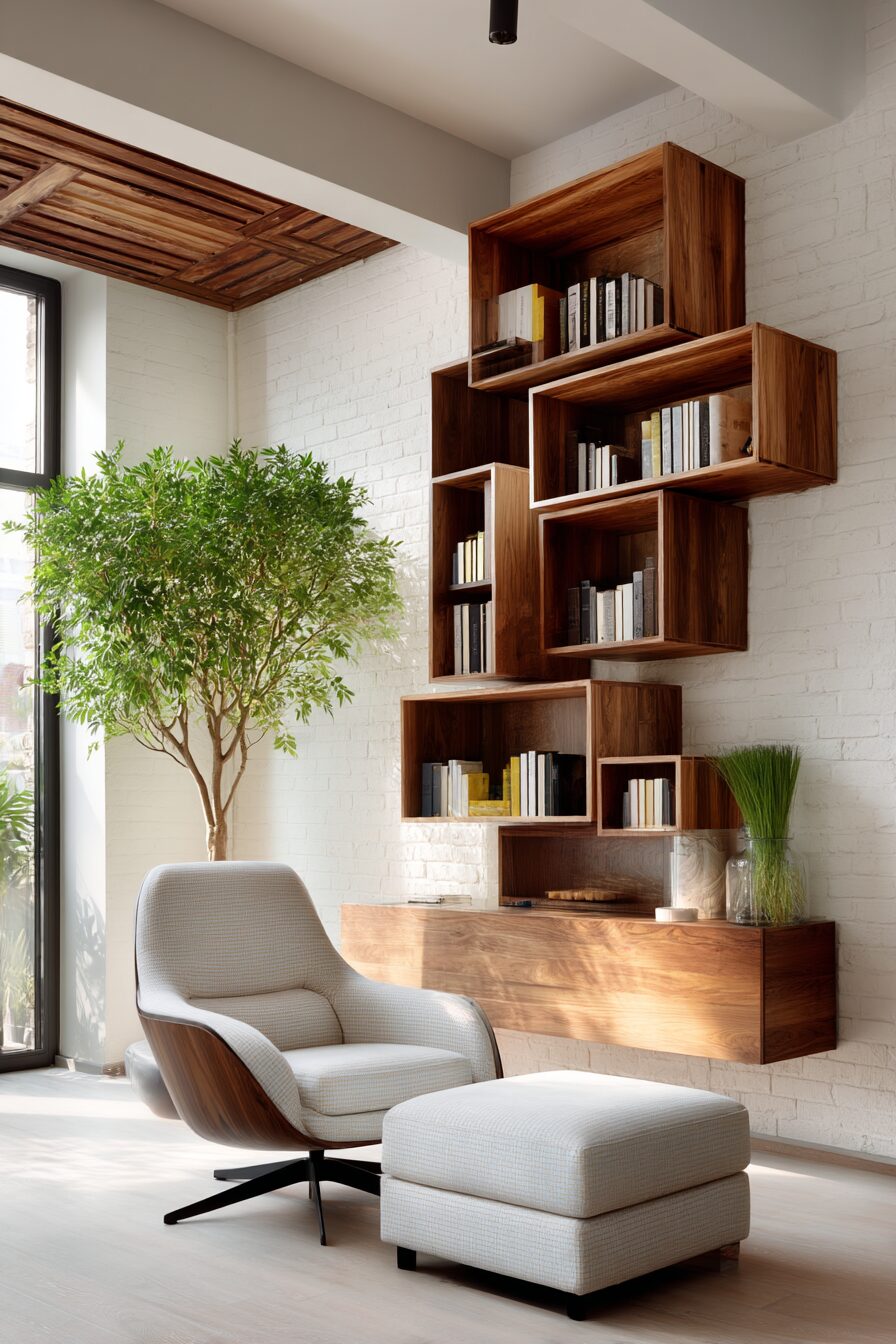Bookshelves aren’t just for storing your favorite reads anymore.
They’ve become the perfect canvas for expressing your personality and style through carefully curated displays.
If you’ve got built-ins, floating shelves, or a standalone bookcase, these mix and match ideas will help you create a stunning visual story that demands attention.
Color-Coded Literary Rainbows
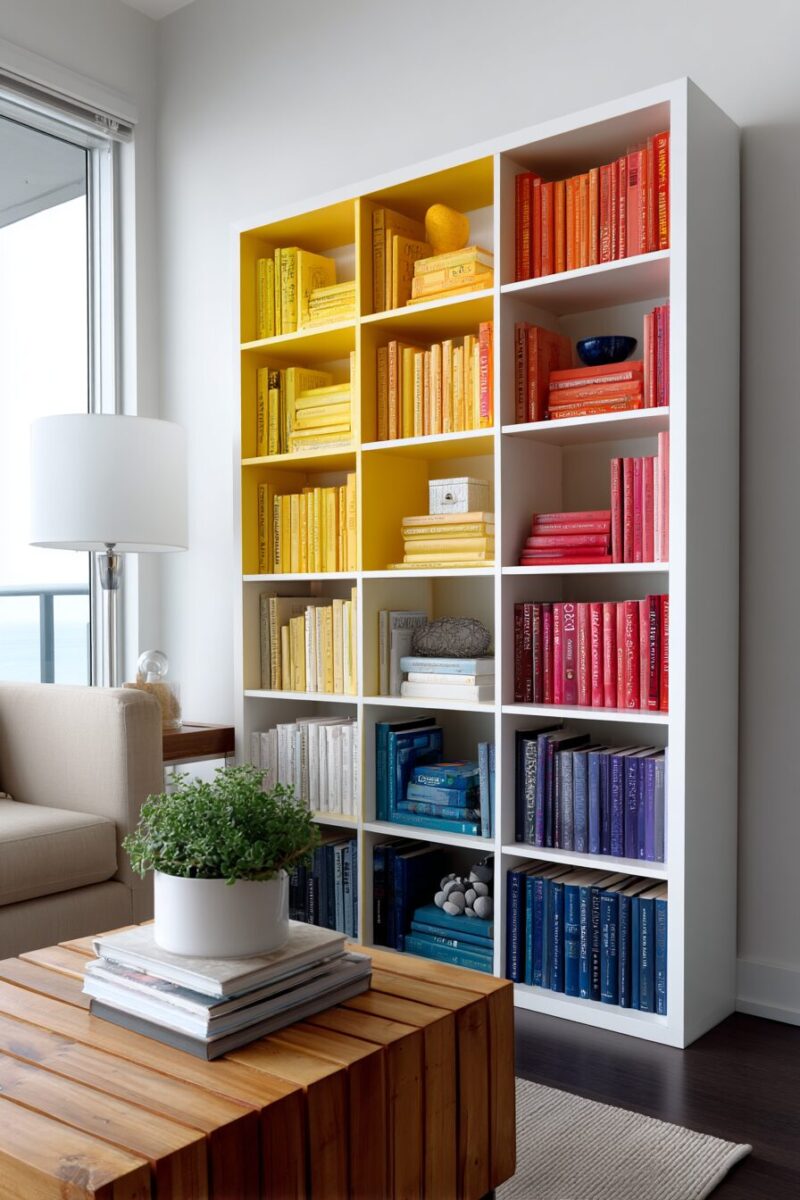
Forget alphabetical order and embrace the visual impact of organizing books by color.
The rainbow bookshelf trend continues to captivate because it instantly transforms your collection into a striking art installation.
Start by sorting all your books by spine color, creating distinct piles of reds, oranges, yellows, greens, blues, purples, whites, and blacks.
Arrange them in rainbow order across your shelves for an effect that’s both organized and dramatically artistic.
For added dimension, try ombré transitions between color groups rather than abrupt changes.
Mix in small decorative objects in complementary colors to enhance each section – like a small red vase among the red books or a blue ceramic figure with the blue spines.
This approach works especially well in neutral rooms where your bookshelf becomes the dramatic focal point.
Don’t worry about finding books in every color – gaps in your rainbow create opportunities for placing decorative objects that continue the color story.
For a sophisticated twist on this trend, try monochromatic arrangements – all white spines with varying textures, or shades of blue from navy to pale sky that create a soothing visual gradient.
Remember that color-coding doesn’t have to cover your entire bookshelf – try applying this technique to just one or two shelves for a controlled pop of organized color.
This arrangement style photographs beautifully for social media and becomes an instant conversation starter when guests visit your home.
Vintage Treasures as Storytelling Bookends
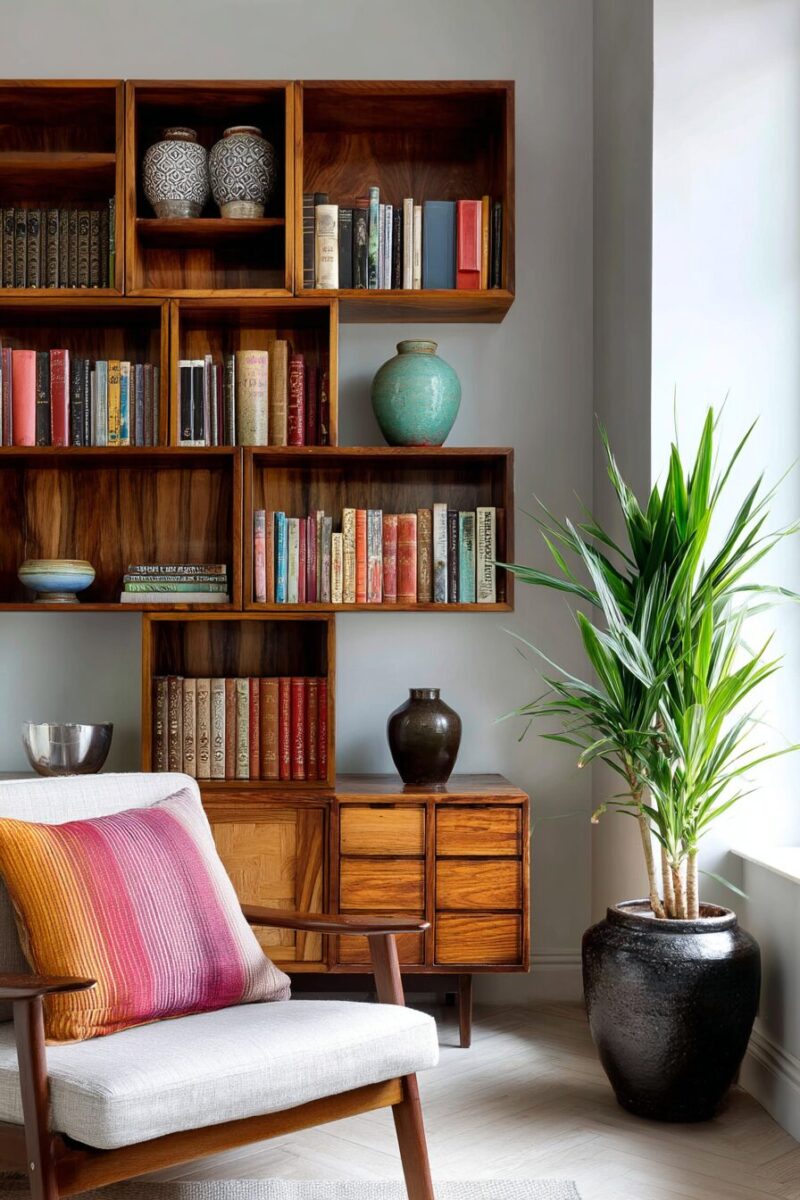

Transform ordinary shelves into fascinating vignettes by incorporating vintage finds as unconventional bookends.
Old cameras, antique brass objects, or reclaimed architectural elements add character while keeping your books neatly upright.
Hunt for matching pairs at flea markets, thrift stores, or online vintage marketplaces to create symmetry across your shelves.
Consider the weight of items when selecting alternative bookends – heavier objects like geological specimens, cast iron figurines, or stone sculptures provide the necessary stability.
Look for items with personal significance that tell your story – perhaps your grandfather’s old typewriter or a collection of vintage globes from your travels.
Mix high and low by pairing luxurious vintage items with quirky thrift store finds for an eclectic, collected-over-time aesthetic.
Small vintage suitcases work beautifully as bookends while offering hidden storage inside for small items you want nearby but out of sight.
Vintage clocks, especially non-working ones set to meaningful times, create conversation-starting bookend moments throughout your shelves.
Antique bookends themselves – often made of brass, wood, or marble – can be found relatively inexpensively and add instant old-world charm.
Try grouping books by genre between themed vintage items – cookbooks between antique kitchen tools or travel guides between souvenir buildings.
Don’t limit yourself to traditional bookend positioning – vintage items can divide books horizontally across a shelf too.
Old wooden boxes or small antique crates provide both boundary and display surface for treasured mementos while supporting your book collection.
This approach transforms your bookshelf from simple storage to a curated museum of personal artifacts and literary companions.
Design Your Dream Room in Minutes!
🏡 Start Creating FREE →Living Library: Plants and Literature Coexistence
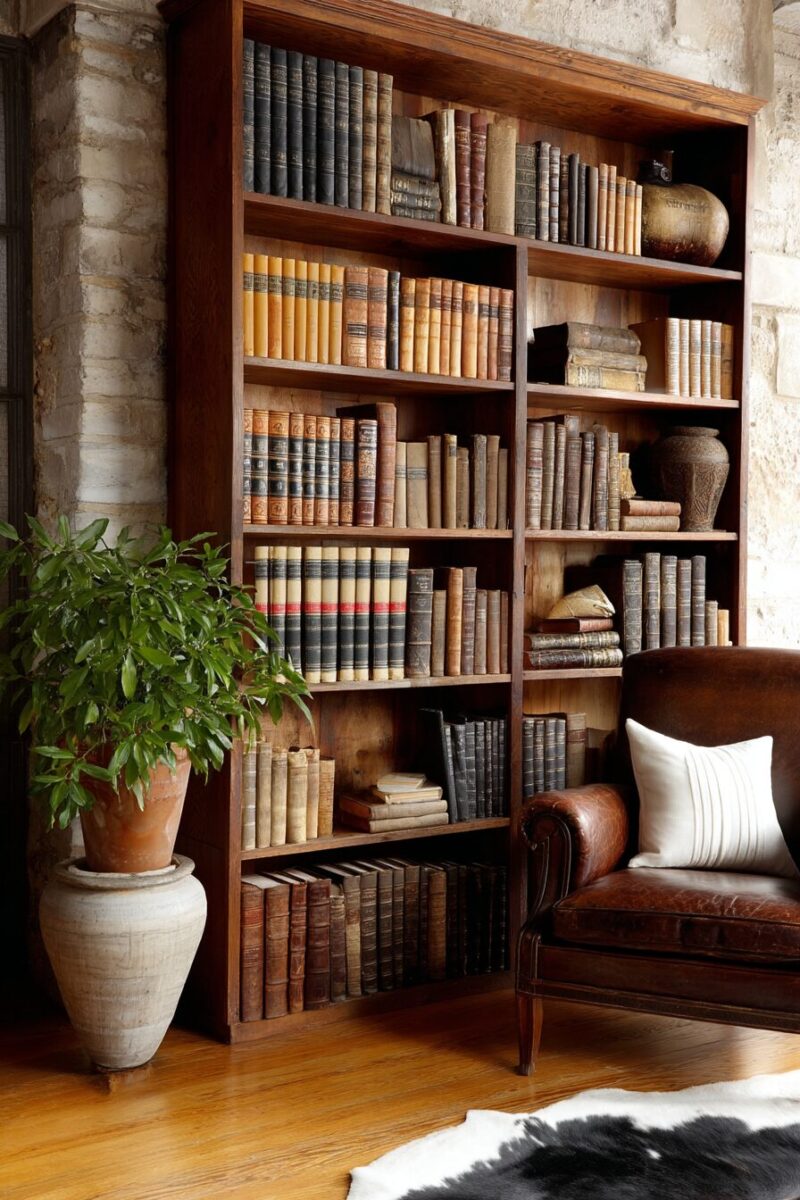
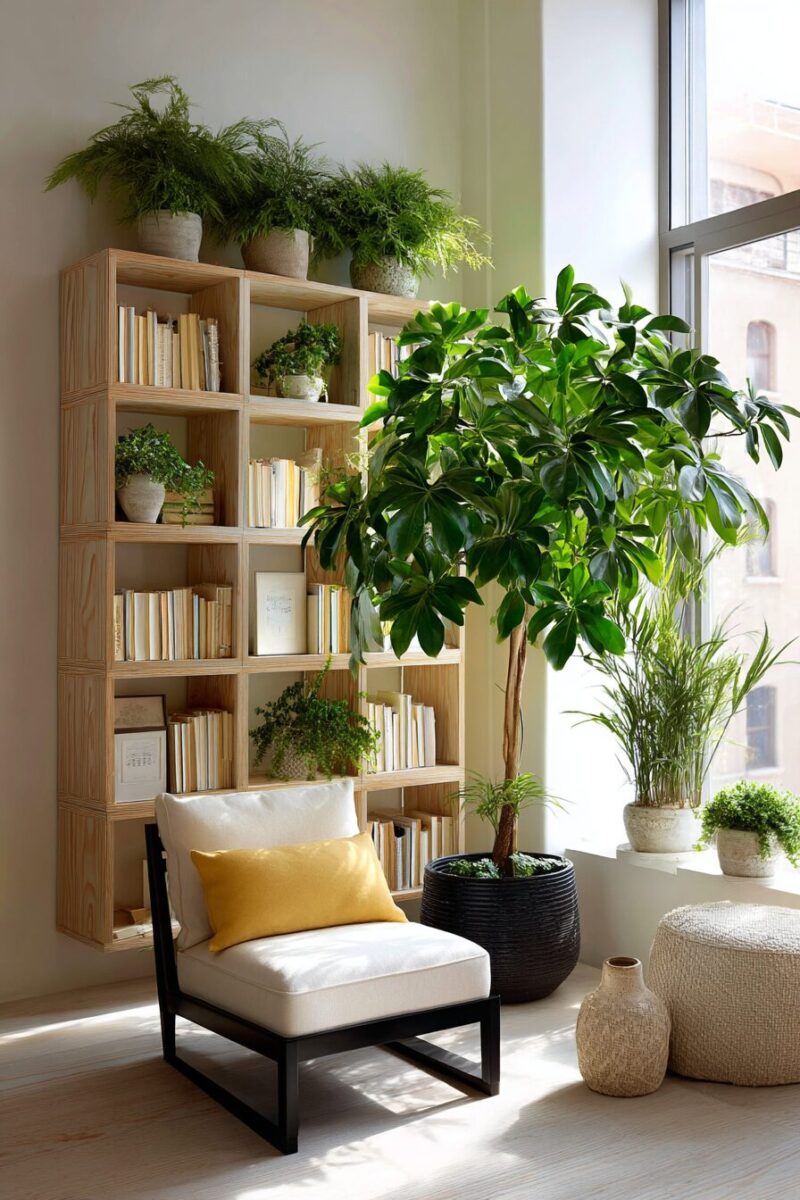
Bring your bookshelves to life—literally—by introducing carefully selected plants that thrive in your specific shelf conditions.
The contrast between lush greenery and paper pages creates a biophilic environment that feels both scholarly and nurturing.
Choose trailing plants like pothos, string of pearls, or ivy to cascade dramatically from upper shelves, creating vertical interest.
For shelves with less height clearance, consider small succulents, air plants, or bonsai specimens that make maximum impact in minimal space.
Incorporate beautiful planters that complement your design aesthetic, from minimalist ceramic vessels to vintage containers repurposed as unexpected plant homes.
Create mini terrarium displays within glass containers for moisture-loving plants that might otherwise be challenging to maintain near paper goods.
Position plants strategically to break up monotonous book rows and create rhythmic visual resting points across your shelving display.
Seasonal flowering plants can be rotated in to refresh your shelves throughout the year—amaryllis for winter, African violets for spring, and so on.
Use plants with interesting textures and forms to contrast with the linear nature of books—the spiky silhouette of aloe against straight book spines creates compelling visual tension.
Integrate preserved botanical elements like dried flowers, framed pressed leaves, or branches for plant-inspired decor without maintenance requirements.
Remember that empty space around plants allows them to serve as focal points rather than getting lost in overcrowded arrangements.
TRENDING NOW
Explore Magic With 10+ Afrohemian Decor IdeasPersonal Gallery Walls Within Shelves
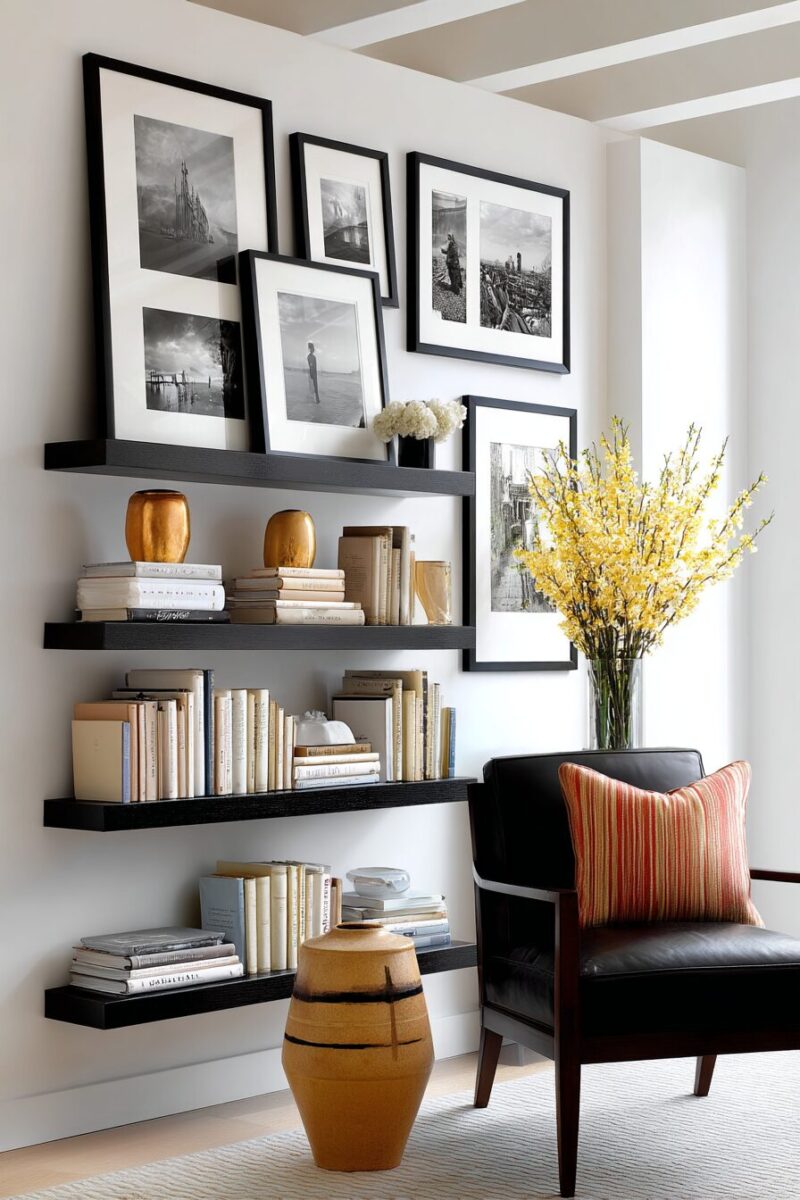
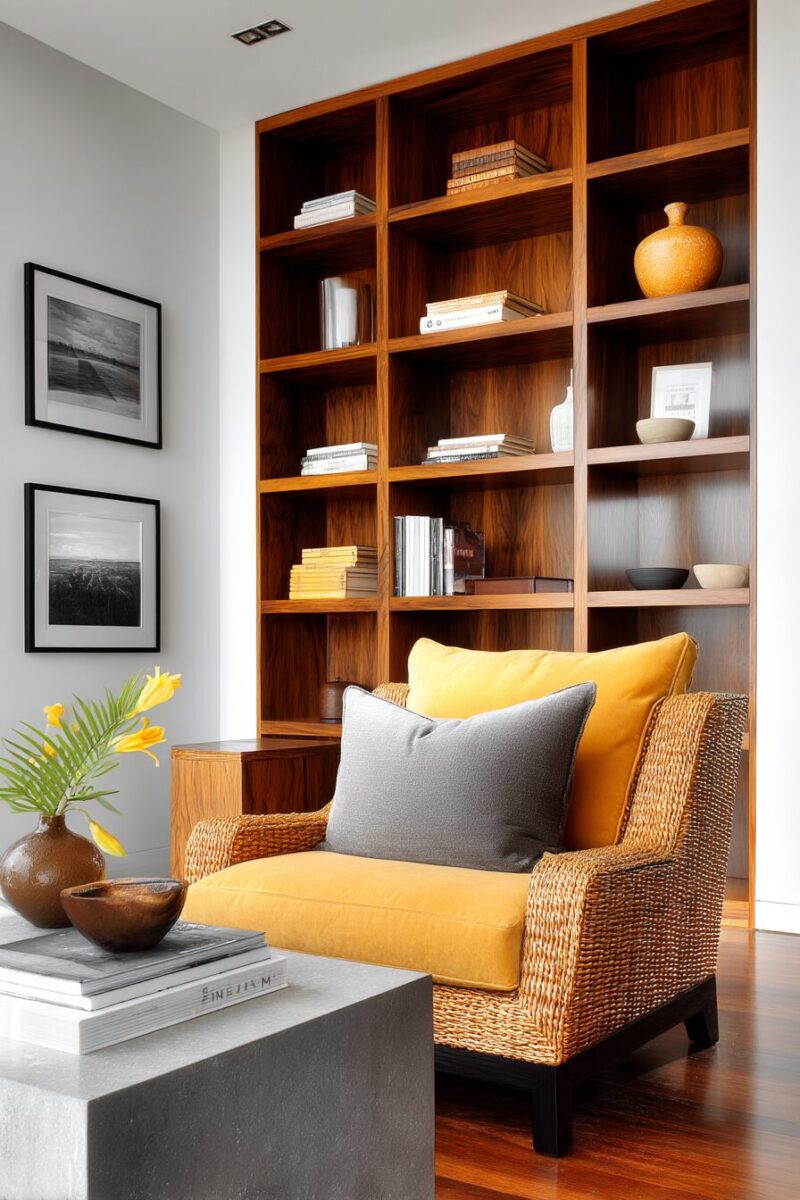
Transform ordinary bookshelves into captivating mini-galleries by incorporating artwork among your books and collectibles.
This approach maximizes your display space while creating dynamic focal points that draw the eye through your shelving arrangement.
Mix framed art of different sizes—from postcard-sized illustrations to larger statement pieces that span multiple shelves—for visual diversity.
Layer smaller frames by leaning them against the back of the shelf, then place shorter books or objects in front for a gallery-style depth effect.
Incorporate affordable art by purchasing art books and displaying favorite pages in simple frames, or framing beautiful postcards collected from museum visits.
Try unexpected art forms like small sculptures, ceramic pieces, or textiles folded to reveal interesting patterns or textures.
Change your shelf gallery seasonally or whenever inspiration strikes—this flexibility lets you enjoy your entire art collection rather than committing to permanent wall installations.
Create themed art moments—perhaps a collection of black and white photographs on one shelf and vibrant abstract pieces on another.
Use small easels or plate stands to prop up unframed art pieces, creating varied heights and angles that add dimension to your shelves.
Remember to leave negative space around key art pieces—crowding diminishes their impact and transforms intentional display into visual clutter.
Unify diverse art styles through consistent framing choices—all black frames or natural wood tones can bring cohesion to eclectic collections.
For family photos, try black and white conversions to create a consistent look that coordinates beautifully with books of any color.
Interactive art elements—like small kinetic sculptures or optical illusions—add playful moments that invite guests to engage with your shelves.
Strategic Lighting to Create Shelf Drama
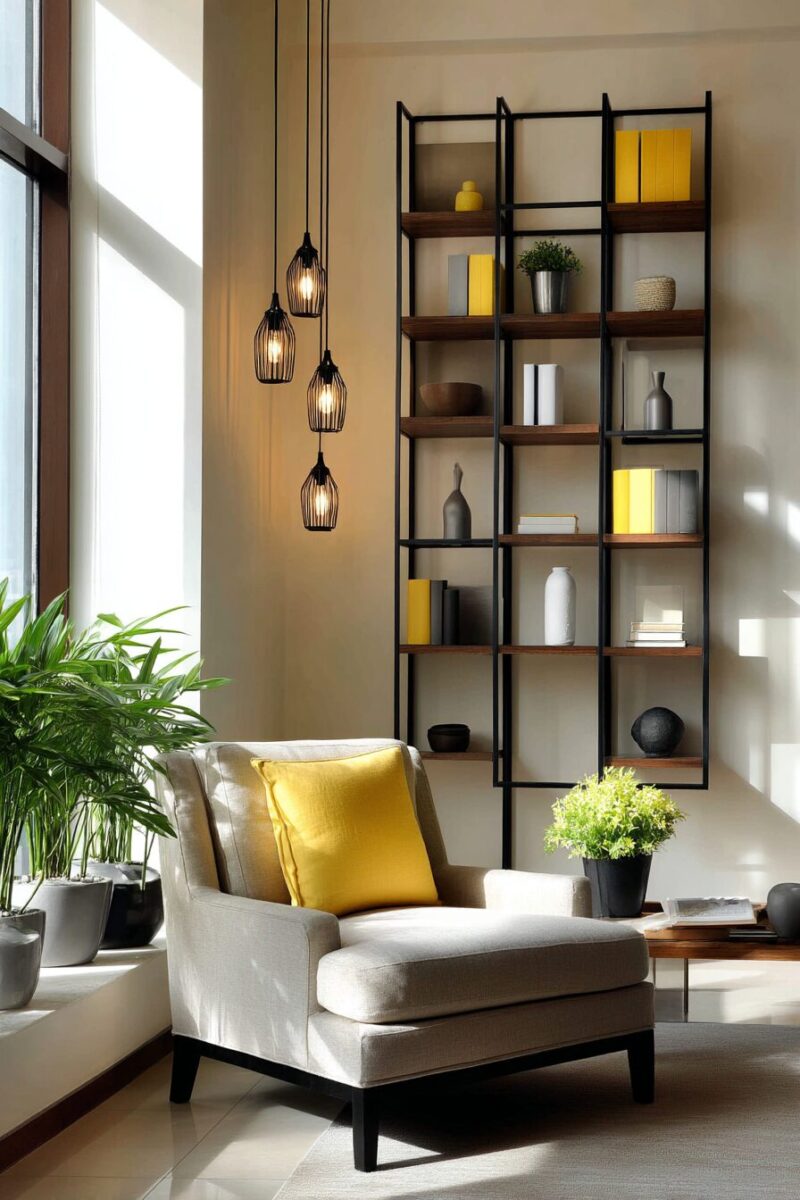
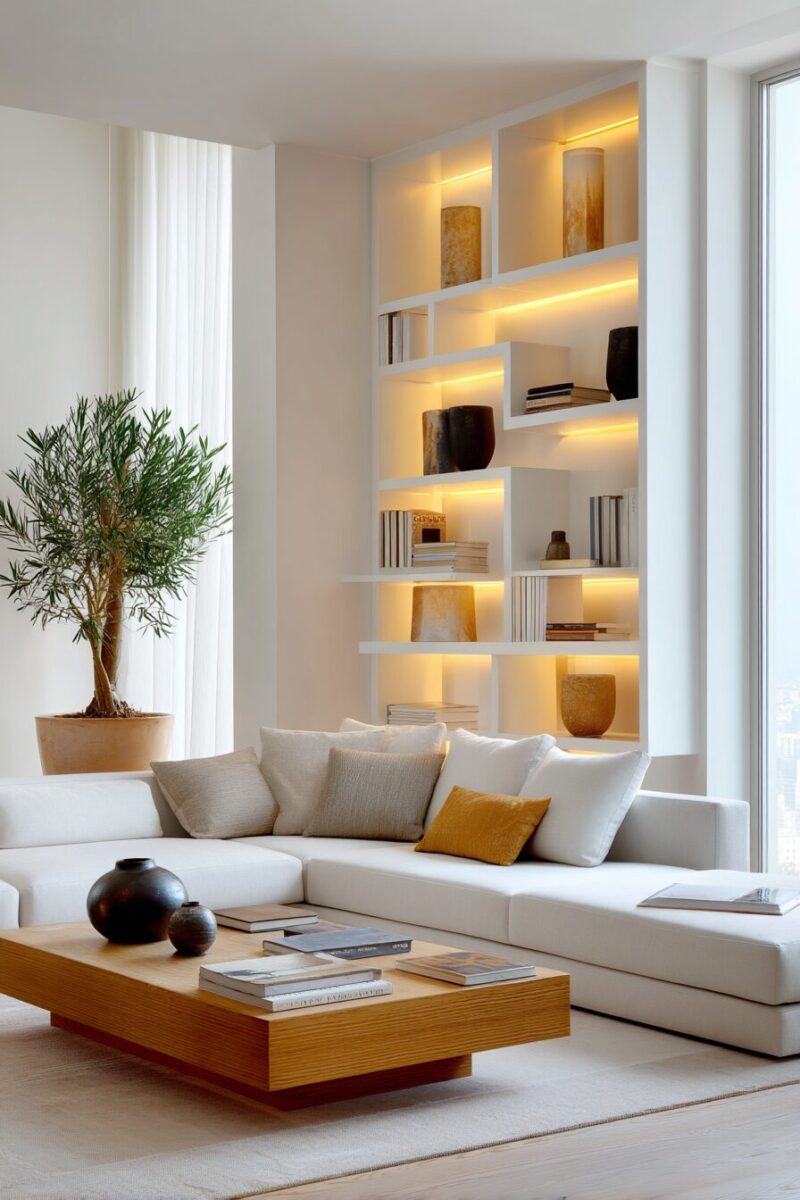
Transform ordinary bookshelves into theatrical displays with thoughtfully positioned lighting elements that highlight your favorite items.
LED strip lighting installed along the underside of shelves creates a floating effect while illuminating the objects below.
Wireless puck lights offer flexibility without visible cords and can be positioned to create spotlighting effects on special collections or art pieces.
Consider color-changing LED options for occasional mood shifts or seasonal displays without rearranging your physical items.
Battery-operated small lamps designed for shelves provide both functional reading light and warm ambient glow that enhances the cozy library feel.
Incorporate mirror-backed sections within shelves to reflect both natural and artificial light, instantly doubling the luminosity and perceived space.
Position shelves strategically near windows where natural light will create dynamic shadow play across your books and objects throughout the day.
Try fairy light strings wound through shelving for a magical effect, especially effective for holiday displays or evening ambiance.
Use directional clip lights attached to shelf edges to highlight specific showcase items without taking up precious shelf space.
Experiment with silhouette effects by placing light sources behind transparent or interestingly shaped objects on your shelves.
Remote-controlled lighting systems allow you to adjust brightness levels for different times of day or activities without disrupting your carefully arranged displays.
Remember that strategic darkness is as important as light—deliberately unlit sections create visual contrast that makes illuminated areas more dramatic.
For a sophisticated approach, consider museum-quality picture lights installed above particularly valuable books or art pieces within your shelving system.
Travel Trophies and Global Inspiration
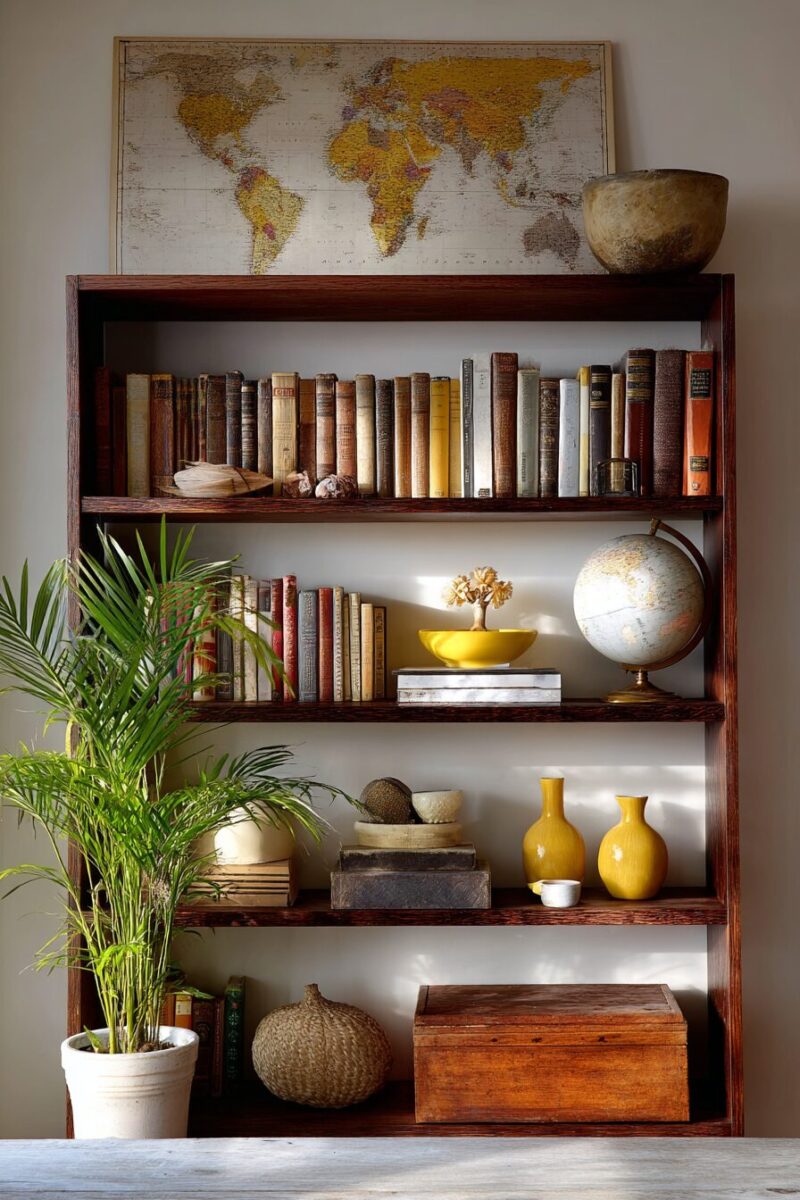
Transform your bookshelves into a personal travel museum by showcasing meaningful souvenirs among your favorite reads.
Unlike tourist trap trinkets, focus on authentic items that capture genuine cultural experiences—a hand-painted tile from Portugal, a carved figure from Indonesia, or a textile fragment from Peru.
Group objects by geographical region or trip to create visual stories across your shelves—your Greek island adventure on one shelf, your Japanese journey on another.
Pair travel objects with related books for context—a miniature Eiffel Tower beside your favorite French novels or a Moroccan tea glass alongside travel guides to Marrakech.
Frame maps, ticket stubs, or currency from significant journeys in simple frames to add flat elements among dimensional souvenirs.
Apothecary jars or small glass containers can beautifully house collections of sand, pebbles, or sea glass gathered from memorable beaches worldwide.
Integrate photo books or small albums featuring highlights from specific destinations, allowing guests to flip through your adventures while admiring your souvenir display.
Use travel items as functional elements—a carved wooden box from Bali becomes a bookend while showcasing beautiful craftsmanship.
Create height variation by displaying items on small stands or risers—a simple wooden block elevates a special stone or figurine for better visibility.
Rotate your travel display seasonally to feature destinations that inspire current daydreams or upcoming adventures.
Incorporate scents through small lidded containers of spices, coffee beans, or tea leaves that transport you back to favorite marketplaces around the world.
Transform beautiful foreign language newspapers or maps into custom book covers for ordinary paperbacks, adding global flair to your entire collection.
Remember that restraint is key—curate your travel treasures to display only those with genuine meaning or aesthetic value rather than every souvenir you’ve collected.
Vertical-Horizontal Rhythm Arrangements
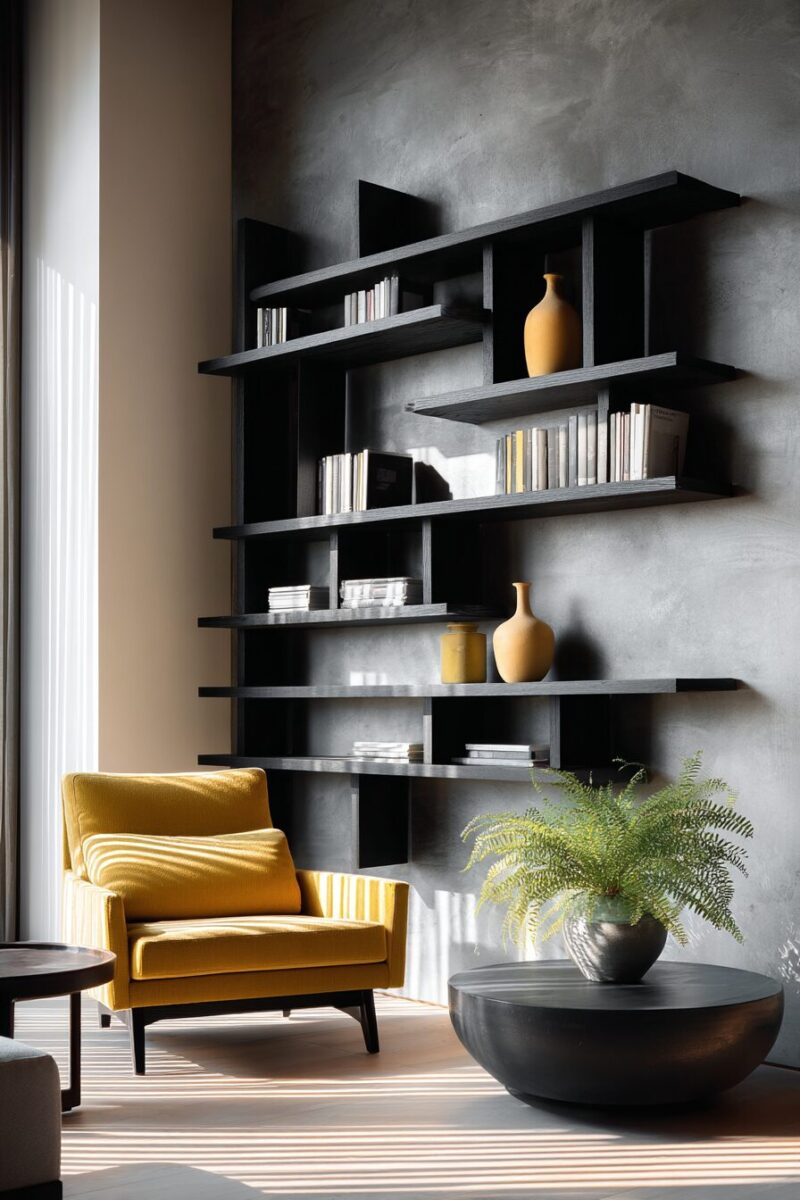
Create visually dynamic bookshelves by strategically alternating between vertical and horizontal book stacking throughout your display.
This technique immediately transforms ordinary shelves into designer-worthy vignettes while maximizing your available space.
Start by arranging most books vertically—spine out—in the traditional manner, leaving strategic gaps for horizontal stacks that will serve as visual punctuation.
Use horizontal book stacks as elevated platforms for displaying decorative objects, creating multiple levels within each shelf section.
Vary the height of your horizontal stacks—some might be three books high while others could be seven or eight—to create undulating rhythms across your shelves.
Place your most visually appealing book covers face-up in horizontal stacks to incorporate their artwork into your overall design scheme.
Try arranging horizontal stacks in pyramid formations with largest books on bottom and smallest on top for stable, sculptural elements.
Use the space on top of horizontal stacks to highlight special objects that might otherwise get lost among vertically arranged books.
Create mini-scenes atop book stacks—a tiny plant alongside a small sculpture or a vintage camera paired with an interesting rock specimen.
Remember that negative space around your arrangements is crucial—avoid the temptation to fill every inch with books or objects.
For larger shelves, try creating horizontal book “bridges” between vertical sections, spanning open spaces with carefully balanced book stacks.
Play with extending horizontal stacks slightly beyond shelf edges for a casual, lived-in feeling that suggests books are actively enjoyed rather than just displayed.
TRENDING NOW
11+ Must-See IKEA Kallax Ideas for Every RoomHidden Functionality and Secret Storage
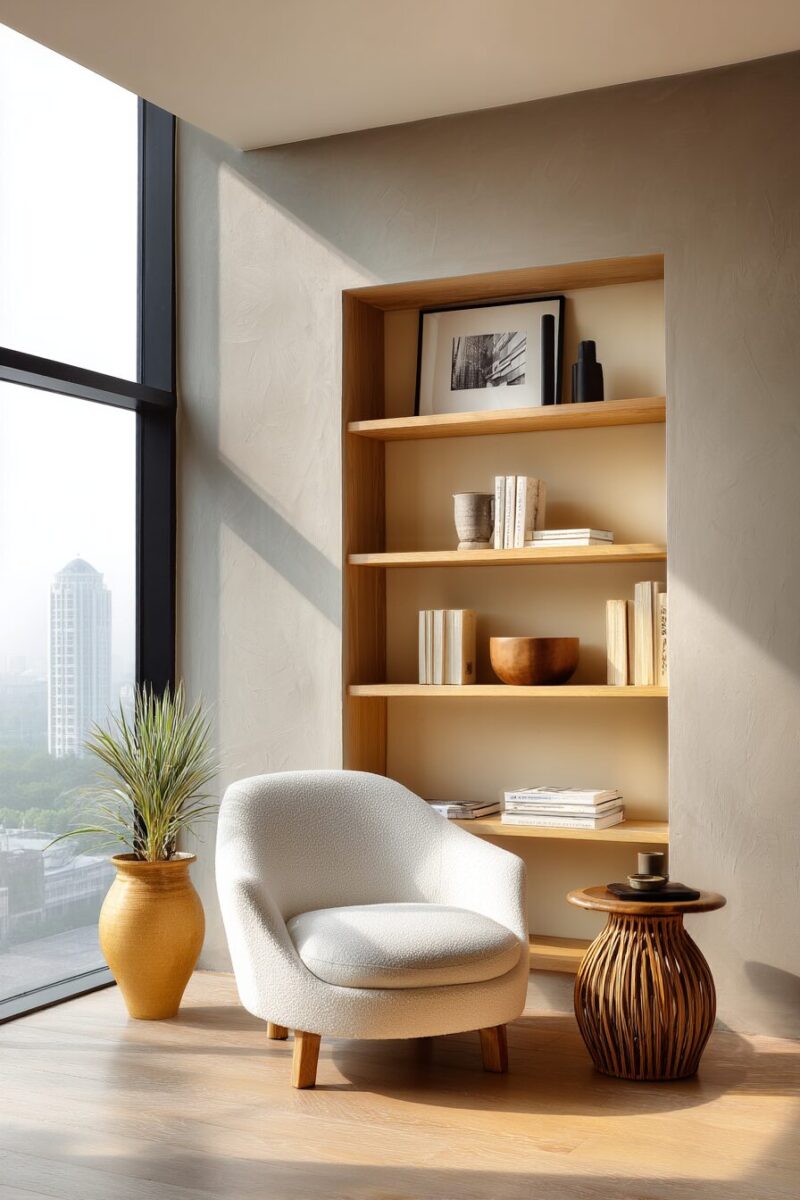
Transform ordinary bookshelves into clever storage solutions by incorporating disguised compartments among your literary displays.
Hollowed-out vintage books with hinged covers make perfect hiding spots for small valuables, remote controls, or items you’d rather keep private.
Decorative boxes designed to resemble leather-bound book collections provide substantial hidden storage while maintaining the library aesthetic.
Install drawer systems within your existing shelving units, disguised behind a row of books, for organizing small items like tech accessories or stationery.
Vintage suitcases or decorative trunks can be placed among books to store seasonal items, craft supplies, or collections not currently on display.
Look for hollow decorative objects—like ceramic statues with removable tops or globes that open to reveal storage space inside.
Fabric-covered storage bins in colors matching your book spines blend seamlessly into your shelf display while containing less attractive necessities.
Retrofit certain sections of bookshelves with small hinged doors that appear to be regular shelf fronts but swing open to reveal storage.
Install pull-out shelves behind your visible book display for double-deep storage, effectively doubling your shelf capacity.
Antique or vintage containers like apothecary jars, film canisters, or tobacco tins make characterful hiding spots for small objects.
Remember that negative space in your arrangement can conceal wall-mounted safes or access panels behind strategically placed books or decorative objects.
Create “bookends” from hollow decorative objects that provide storage while serving a functional purpose in your shelf arrangement.
Seasonal Rotation Systems for Ever-Changing Displays
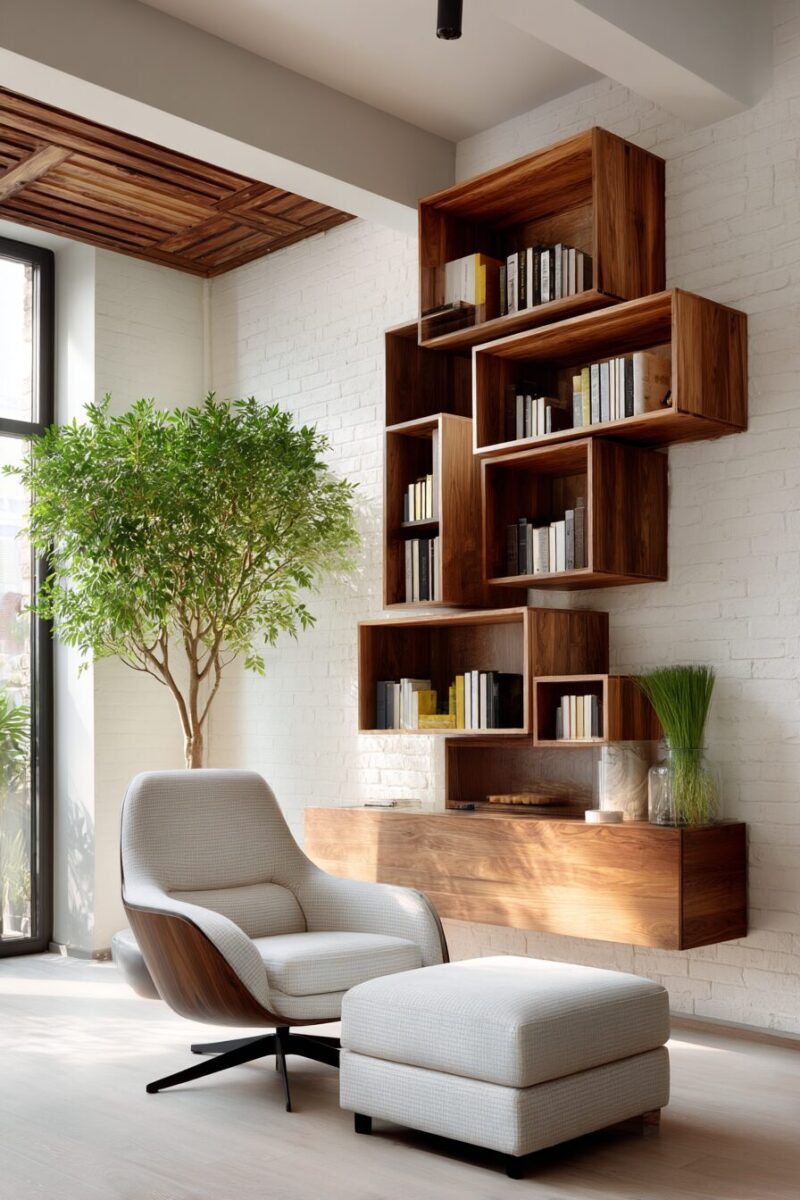
Keep your bookshelf displays feeling fresh and relevant by implementing a seasonal rotation system that transforms your space throughout the year.
Create a dedicated storage area—perhaps bins in a closet or basement—to house off-season decor items between their showcase periods.
Develop a simple calendar system that reminds you when it’s time to refresh your shelves, perhaps aligned with the solstices and equinoxes for natural seasonal divisions.
For winter displays, incorporate elements that create warmth and coziness—think small battery-operated candles, metallic accents, and rich, deep colors.
Spring shelf arrangements might feature botanical elements like pressed flowers, light pastel ceramics, and nature-inspired bookends or figurines.
Summer displays could showcase vacation mementos, sea glass collections, or books with brightly colored spines arranged for maximum visual impact.
Autumn shelf styling might include natural elements like pinecones, small gourds, or amber-colored glass objects interspersed among warm-toned books.
Rotate your actual book selection seasonally, bringing forward cooking books during holiday baking seasons or gardening guides in spring planting months.
Change the orientation and arrangement style of books with each rotation—perhaps color-coding for summer, genre-grouping for fall, and size-arrangement for winter.
Photograph each successful seasonal arrangement to reference when planning future displays and to track what combinations worked best.
Use consistent elements that remain year-round as anchoring pieces while changing out smaller accessories for seasonal variation.
Remember that seasonal rotation doesn’t require purchasing new items constantly—repurposing objects from elsewhere in your home keeps your shelves looking new without added expense.
TRENDING NOW
12 Family Photo Wall Ideas To Showcase Your MemoriesPersonal Collection Showcases Beyond Books
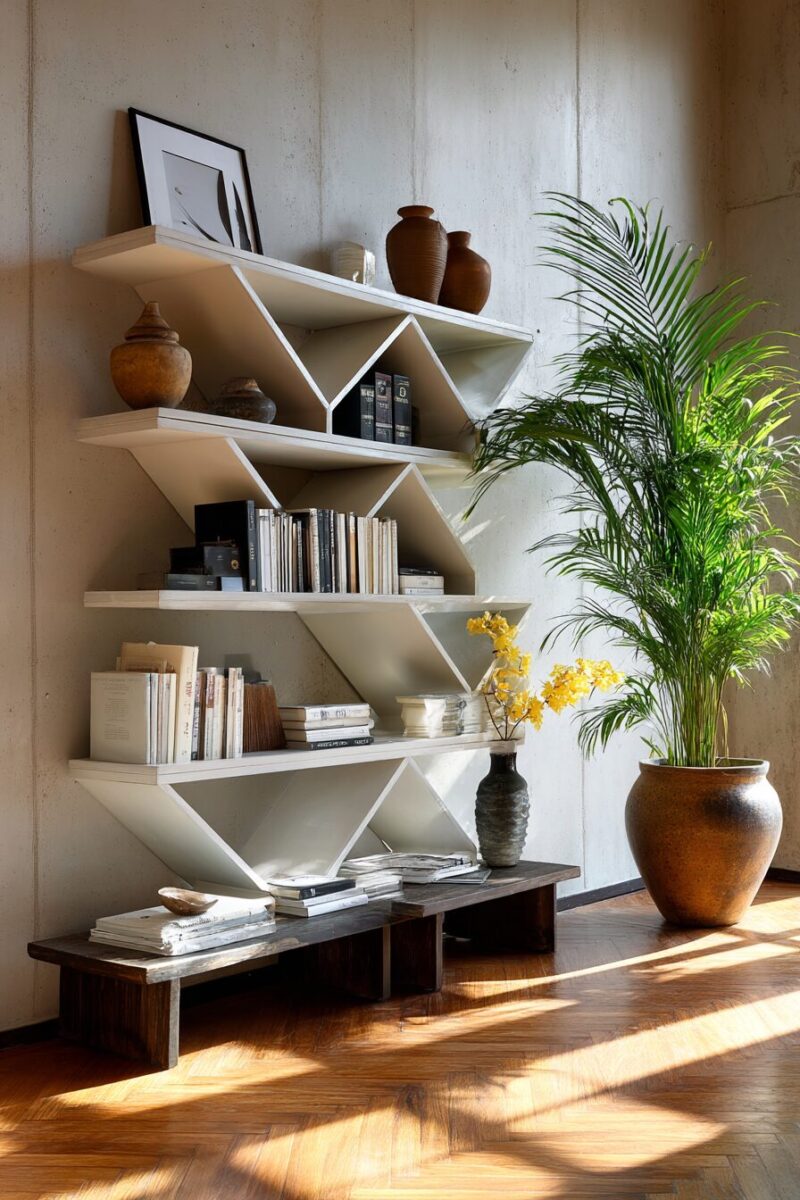
Transform ordinary bookshelves into museum-worthy displays by incorporating your unique collections among literary treasures.
The key to successful collection displays lies in thoughtful curation—select only the most interesting or beautiful examples rather than showing every item you own.
Create visual impact through grouping—fifteen vintage cameras clustered together make a stronger statement than the same cameras scattered randomly throughout your shelves.
Consider the story behind your collections and how to communicate that narrative through your arrangement—perhaps chronologically or by sub-category.
For collections with many small pieces, try glass-fronted cabinets within your shelving system to protect items from dust while keeping them visible.
Rotate featured pieces from larger collections seasonally to keep your displays fresh without overwhelming your space.
Look for creative ways to elevate collections—small acrylic risers, vintage cigar boxes, or stacked books can create varying heights for better visibility.
Incorporate relevant books among your collections—vintage cookbooks beside antique kitchen tools or art books among pottery pieces—to create context.
For flat collections like postcards or vintage advertisements, invest in archival display albums that can be shelved spine-out but easily retrieved for viewing.
Group items by color, size, or material to create visual patterns within your collection display rather than random arrangements.
Leave negative space around special collection pieces—breathing room ensures each item can be appreciated rather than lost in visual clutter.
For particularly valuable collections, consider UV-protective glass inserts or acrylic covers to prevent sun damage while keeping items visible.
Remember that your bookshelves should reflect your authentic interests—whether you collect vintage typewriters, geological specimens, or Star Wars figurines, display them proudly among your books.
Don’t feel pressured to implement all these ideas at once—even incorporating just one or two concepts can dramatically transform your shelves.
The beauty of bookshelf styling lies in its flexibility—you can continuously evolve your displays as your collections and preferences change over time.
Trust your eye and personal taste above all design “rules”—the most compelling shelf arrangements reflect authentic personality rather than perfectly following trends.

